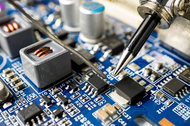Five Soldering Tips You Should Know
Posted by Admin on Sep 30th 2021
Soldering is integral to the PCB fabrication and assembly process. It involves joining various metal types together by melting and flowing a filler metal into the joint. The solder or filler metal is an alloy that you can melt with the help of a hot iron at a temperature higher than 600 degrees Fahrenheit. As the molten solder cools down, it creates a robust electrical bond between various parts. It can form permanent connections, but one can also reverse it using the desoldering process.
You can use IPC solder kits to learn and perform the soldering process. Place the soldering iron on its stand, and plug it in to heat it. Use a damp sponge to clean the iron tip. Start to melt a bit of solder on the iron tip; it will help get the flow going from the iron to the joint. If it does not flow, use a damp sponge to clean it. If the molten solder shines bright silver on the iron tip, you can start with the soldering process. Prepare the surface to solder on, and clean it using a woolen cloth for removing any residue. Heat the target connections for few seconds, then apply the solder. Keep the iron tip in the target place, and ensure that the solder flows seamlessly in the heated areas in the connection. When it forms a strong connection, remove the iron tip and solder. Finally, remove the soldering iron, and allow the bond to cool down. Once it is done, manually inspect the connection to ensure that it is consistent and robust.
When performing soldering, you can refer to the following tips.
Clean The Material
For effective soldering, cleaning the material is extremely important. It helps to remove harmful contaminants and adhesive residues to allow the solder to flow easily. The metal, including the flux and solder, must be clean. Dirt, grease, or oxides create a barrier between the metal and the solder.
Pre-Tin Joints
The pre-tinning technique helps to improve solderability. It helps in removing gold from the lead of the transistor before soldering components on the circuit board. Pre-tinned joints before soldering are more durable and more robust. It helps to build longevity in your work.
Do Not Re-Solder a Broken Seam.
A broken solder joint allows moisture to enter quickly. It will lead to the oxidation of the solder, and hence soldering a new joint is not a good idea.
Materials You Can Use for Soldering.
The growing environmental concerns require the electronics industry to produce lead-free products. They must comply with the RoHS (Restriction of Hazardous Substances) directive. Due to regulations, filler metals used in soldering are mostly lead-free, consisting of antimony, bismuth, brass, copper, indium, tin, or silver.
Flux To Use
Based on the material you are soldering, you need to decide the flux to use. Soldering flux prevents metal oxidation, which can otherwise cause poor adherence to solder. Some metals require a more aggressive or acidic flux for achieving a proper joint. Ensure that you clean the surface to remove the flux residue, which can otherwise corrode the metal.
To Conclude:
These tips will help you perform soldering efficiently and will give you an edge over your competitors. It will help you conduct soldering smoothly and seamlessly and ensure that the solder forms strong bonds for better durability and quality.

